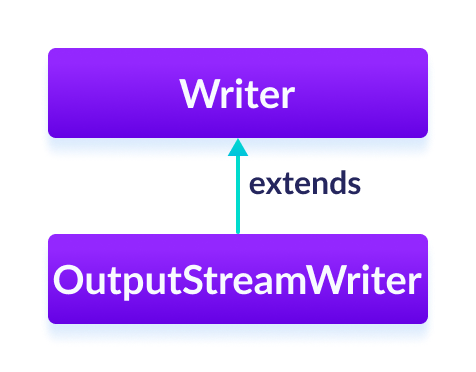The OutputStreamWriter class of the java.io package can be used to convert data in character form into data in bytes form.
It extends the abstract class Writer.

The OutputStreamWriter class works with other output streams. It is also known as a bridge between byte streams and character streams. This is because the OutputStreamWriter converts its characters into bytes.
For example, some characters require 2 bytes to be stored in the storage. To write such data we can use the output stream writer that converts the character into corresponding bytes and stores the bytes together.
Create an OutputStreamWriter
In order to create an OutputStreamWriter, we must import the java.io.OutputStreamWriter package first. Once we import the package here is how we can create the output stream writer.
// Creates an OutputStream
FileOutputStream file = new FileOutputStream(String path);
// Creates an OutputStreamWriter
OutputStreamWriter output = new OutputStreamWriter(file);
In the above example, we have created an OutputStreamWriter named output along with the FileOutputStream named file.
Here, we are using the default character encoding to write characters to the output stream.
However, we can specify the type of character encoding (UTF8 or UTF16) to be used to write data.
// Creates an OutputStreamWriter specifying the character encoding
OutputStreamWriter output = new OutputStreamWriter(file, Charset cs);
Here, we have used the Charset class to specify the type of character encoding.
Methods of OutputStreamWriter
The OutputStreamWriter class provides implementations for different methods present in the Writer class.
write() Method
write()- writes a single character to the writerwrite(char[] array)- writes the characters from the specified array to the writerwrite(String data)- writes the specified string to the writer
Example: OutputStreamWriter to write data to a File
import java.io.FileOutputStream;
import java.io.OutputStreamWriter;
public class Main {
public static void main(String args[]) {
String data = "This is a line of text inside the file.";
try {
// Creates a FileOutputStream
FileOutputStream file = new FileOutputStream("output.txt");
// Creates an OutputStreamWriter
OutputStreamWriter output = new OutputStreamWriter(file);
// Writes string to the file
output.write(data);
// Closes the writer
output.close();
}
catch (Exception e) {
e.getStackTrace();
}
}
}
In the above example, we have created an output stream reader using the file output stream. The output stream reader is linked with the output.txt file.
FileOutputStream file = new FileOutputStream("output.txt");
OutputStreamWriter output = new OutputStreamWriter(file);
To write data to the file, we have used the write() method.
Here, when we run the program, the output.txt file is filled with the following content.
This is a line of text inside the file.
getEncoding() Method
The getEncoding() method can be used to get the type of encoding that is used to write data to the output stream. For example,
import java.io.OutputStreamWriter;
import java.nio.charset.Charset;
import java.io.FileOutputStream;
class Main {
public static void main(String[] args) {
try {
// Creates an output stream
FileOutputStream file = new FileOutputStream("output.txt");
// Creates an output stream reader with default encoding
OutputStreamWriter output1 = new OutputStreamWriter(file);
// Creates an output stream reader specifying the encoding
OutputStreamWriter output2 = new OutputStreamWriter(file, Charset.forName("UTF8"));
// Returns the character encoding of the output stream
System.out.println("Character encoding of output1: " + output1.getEncoding());
System.out.println("Character encoding of output2: " + output2.getEncoding());
// Closes the reader
output1.close();
output2.close();
}
catch(Exception e) {
e.getStackTrace();
}
}
}
Output
The character encoding of output1: Cp1252 The character encoding of output2: UTF8
In the above example, we have created 2 output stream writer named output1 and output2.
- output1 does not specify the character encoding. Hence the
getEncoding()method returns the default character encoding. - output2 specifies the character encoding, UTF8. Hence the
getEncoding()method returns the specified character encoding.
Note: We have used the Charset.forName() method to specify the type of character encoding. To learn more, visit Java Charset (official Java documentation).
close() Method
To close the output stream writer, we can use the close() method. Once the close() method is called, we cannot use the writer to write the data.
Other methods of OutputStreamWriter
| Method | Description |
|---|---|
flush() |
forces to write all the data present in the writer to the corresponding destination |
append() |
inserts the specified character to the current writer |
To learn more, visit Java OutputStreamWriter (official Java documentation).